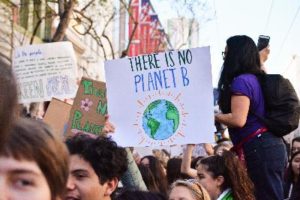A Roadmap to Sustainability for Your Municipality
Wondering how you can help your municipality be more environmentally sustainable? Look no further! Volunteers from the Capital District in New York State have created a detailed document outlining specific actions you can take. Get started by exploring our website and clicking the recommended actions below.
Roadmap Summary
Climate change is one of the greatest existential threats facing our society, on the same scale as nuclear war, asteroid impacts, and global pandemics. The buildup of greenhouse gases in the atmosphere has reached levels (410 ppm of CO2) not seen since 3.2 million years ago, when our Australopithecus ancestors roamed Africa and sea levels were 80 feet higher than they are now. Scientists no longer debate whether man-made climate change is happening. The scientific discourse now revolves around whether or not today’s society can survive the predicted upheavals brought on by food and water scarcity and resulting population migrations, how close the world is to several “tipping points” that would irreversibly push the climate into a new regime, and whether it’s worth the risk to undertake planetary-scale geoengineering projects such as blocking sunlight with man-made haze in the upper atmosphere.
Against this backdrop of a world in a slow-moving emergency, various levels of government have finally started to take serious action on climate change mitigation after decades of urging by scientists and other concerned citizens. Nations have a framework for addressing climate change under the Paris Agreement. President Biden has proposed a large infrastructure investment that would address some aspects of a climate solution, such as the electric grid and electric vehicles. New York State passed the Climate Leadership and Community Protection Act (CLCPA), which targets 70% Renewable Energy by 2030, 100% Zero-emission Electricity by 2040, and 85% Reduction in Greenhouse Gas (GHG) Emissions by 2050.
Municipal governments have an important role in addressing climate change mitigation too. Some acted early and are now far ahead of Capital Region municipalities. For example, many cities in California, Ithaca, and New York City have proven to be leaders.
Volunteers from two groups, Bethlehem Tomorrow and Capital District Community Energy, researched climate change mitigation actions that are within the jurisdiction of Capital District municipalities. Most of the volunteers have professional experience related to climate change mitigation, ranging from engineering and research to public policy and administration. None of the volunteers have financial interests in this topic that would result in monetary gains if the recommended actions are adopted. The volunteers examined the actions undertaken by other municipalities across the country and actions recommended by New York state agencies and various nonprofits. This website describes the actions that the volunteers recommend be undertaken by municipalities in the Capital Region of New York State.

The actions are divided into the four main strategies that are needed to decarbonize the US energy system, which need to be carried out simultaneously:
- Electrification. Direct uses of fossil fuels, such as for heating and transportation, are replaced by use of renewable energy.
- Clean energy. Electricity and other forms of energy are derived from renewable energy, such as solar, wind, hydro power, geothermal, and biomass.
- Energy efficiency. This will facilitate the transition of the first two strategies.
- Carbon sequestration. A portion of GHG can be removed from the atmosphere and stored for long periods.
The actions are also divided into four end-use application areas:
- Buildings
- Transportation
- Infrastructure, land use, and outdoor lighting
- Consumption and services.
Recommended ACTIONS
The recommended actions are shown in the table below. Each action is described in more detail on each action’s page. Follow the links to learn more!
Note: while some of the actions can be fully implemented today, others will require a more gradual adoption and implementation phases are recommended.
| Application area | Strategies | |||
|---|---|---|---|---|
| Electrification | Clean energy | Energy efficiency | Carbon sequestration/prevention | |
| Buildings | EL1. Require heat pumps.
EL2. Prohibit fossil fuel hookups and storage. EL3.Enact seasonal bans on internal combustion outdoor equipment. |
CE1. Require on-site PV.
CE2. Orient new buildings for solar energy.
|
EE1. Adopt stringent energy code.
EE2. Improve energy efficiency in existing buildings. |
CS1. Require developers to offset increased emissions. |
| Transportation | EL4.Require electric vehicle charging capability at residential properties.
EL5. Ensure access to public electric vehicle charging. |
EE5. Encourage reduced vehicle miles traveled. | ||
| Infrastructure & land use | EL8. Prohibit new or expanded fossil fuel dispensing. | CE3. Zone suitable locations for grid-scale renewables and electricity storage. | EE7. Convert municipal streetlights to LEDs. | CS2. Reforest and maintain forests. |
| Consumption & services | EE8. Encourage purchase of locally produced goods and food. | |||
Implementation Actions (IMs)
There are a number of steps required to implement the climate change mitigation measures recommended in our roadmap.
- IM1. Add actions to comprehensive plan.
- IM2. Require actions through regulation.
- IM3. Encourage measures through financial incentives.
- IM4. Hire and train municipal staff.
- IM5. Convene municipal sustainability committee.
- IM6. Cooperate with other regional municipalities.
- IM7. Conduct education and outreach.
- IM8. Encourage availability of professional services.
- IM9. Purchase materials and equipment in bulk and resell to residents.
- IM10. GHG Inventory, benchmarking, and accountability.
Check out our Implementation Actions section by clicking the button.
Take action today!
We are always looking for volunteers to help us improve municipal sustainability.
Bethlehem Tomorrow and Capital District Community Energy are dedicated to greening the Capital Region in New York State.
If you are interested in learning more about us or joining our team(s), please reach out to us anytime via email or Facebook using the links below.